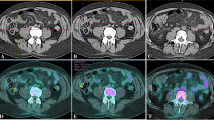Abstract.
Technetium-99m labelled antigranulocyte antibodies are ready to use and are sensitive and specific in the diagnosis of infectious diseases. 99mTc-SSEA antigranulocyte antibodies have a very high affinity constant (K d 10–12 M) for human neutrophils (PMNs), and excellent imaging qualities with high target/background ratios. The aim of this study was to compare the diagnostic accuracy of the 99mTc-anti-SSEA-1 monoclonal antibody (Mab) with that of 99mTc-hexamethylpropylene amine oxime (HMPAO)-labelled white blood cells (WBCs). To this end, 17 patients with 23 proven infectious foci were examined with 555 MBq 99mTc-anti-SSEA-1 MAb and with 370 MBq 99mTc-HMPAO labelled autologous leucocytes within a period of 7 days. All the infections were confirmed by culture, biopsy, surgery and follow-up. Whole-body images and planar spot views with the antibody were performed at 1-h, 4-h and 24-h post injection; the biodistribution of the antibody was quantified, absorbed radiation doses were calculated and the diagnostic results were compared with the 99mTc-HMPAO WBC images. Human anti-mouse antibody (HAMA) evaluation was performed in all patients before and 3 months after antibody injection. Blood was drawn at different times after 99mTc-anti-SSEA-1 MAb injection to determine the amount of granulocyte-associated radioactivity and to calculate recovery. 99mTc-anti-SSEA-1 MAb scintigraphy detected all 23 lesions, while 21 were detected with 99mTc-HMPAO WBC scan. In this small group of patients, the sensitivity and specificity of 99mTc-anti-SSEA-1 MAb scintigraphy were 95% and 96% respectively, as compared with 91% and 82% respectively for 99mTc-HMPAO WBC scan. An increasing uptake of the injected activity in the lesion at different time points was indicative of high affinity and of specific PMN binding.There was no HAMA formation. In four of five patients investigated, a transient mild leukopenia was found at 15 min p.i.. There was increased uptake of the antibody in liver and spleen and normal uptake in kidneys and bone marrow.The estimated radiation doses for the whole body and the red bone marrow were 1.1×10–2 cGy/37 MBq and 5.3×10–2 cGy/37 MBq, respectively. The activity associated to the PMNs in vivo was 33.5%, 30.6%, 21.3% and 9% at 5, 15, 30 and 45 min. post-injection, respectively. It is councluded that use of 99mTc-anti-SSEA-1 antigranulocyte antibodies demonstrates promising results comparable to those obtained with 99mTc-labelled autologous WBCs. The 99mTc-labelled MAb is ready to use, has excellent image qualities and a high target/background ratio.
Similar content being viewed by others
Author information
Authors and Affiliations
Additional information
Received 16 October and in revised form 17 December 1997
Rights and permissions
About this article
Cite this article
Gratz, S., Behr, T., Herrmann, A. et al. Intraindividual comparison of 99mTc-labelled anti-SSEA-1 antigranulocyte antibody and 99mTc-HMPAO labelled white blood cells for the imaging of infection. Eur J Nucl Med 25, 386–393 (1998). https://doi.org/10.1007/s002590050236
Issue Date:
DOI: https://doi.org/10.1007/s002590050236




